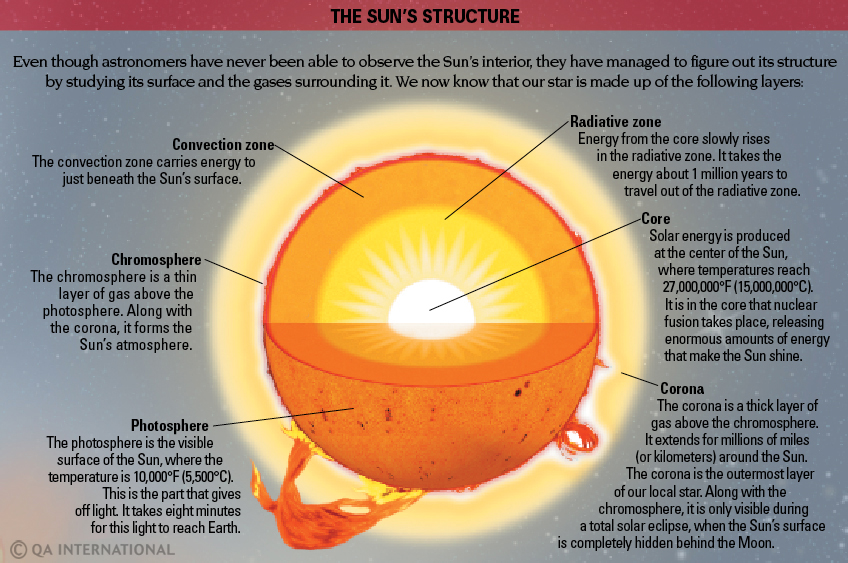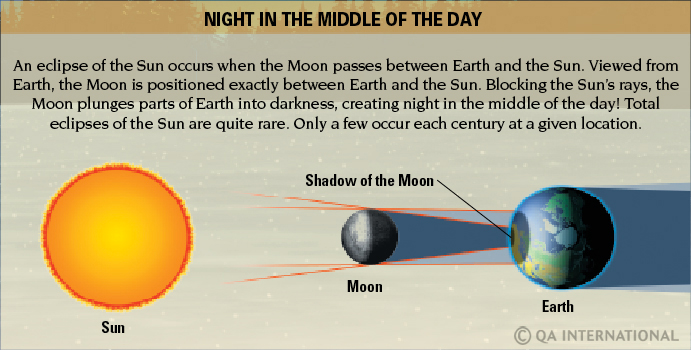
Solar phenomena: when the Sun moves, Earth reacts!
The Sun is a star just like any of the other thousands of bright spots twinkling in the night sky. It appears enormous compared to the other stars only because it is so close to Earth. In fact, the Sun is an ordinary medium-sized, yellow-white star. What makes it unique is that it is our star, the one that gives us light and keeps us warm. Without the Sun’s energy, our planet would be nothing more than a lifeless, cold, dark sphere floating in space. Like all stars, the Sun will someday be extinguished, but it’s not time to worry yet. It has only reached its midlife point, so our star should continue to light and heat Earth for another 5 billion years or so!
A heavyweight champion
By any measure, the Sun is the most impressive object in our solar system. If the Sun were empty inside, it could hold more than a million planets the size of Earth. The Sun alone accounts for 99.8% of the solar system’s total mass. Even giant Jupiter, the largest of the eight planets, appears tiny next to this heavyweight champion!
The solar furnace
Like the other stars, the Sun is an enormous ball of burning, hot gases—mostly hydrogen and helium. At the core of the Sun, where the temperatures are highest, hydrogen atoms experience such enormous pressure and temperature that the atoms stick together and are transformed into helium. Each second, more than 600 million tons (550 million metric tons) of hydrogen are turned into helium this way. This phenomenon, which is called nuclear fusion, releases massive amounts of energy. The energy takes about 1 million years to move from the Sun’s core to its surface, where it gives off heat and light!

Solar phenomena
The surface of the Sun is a boiling place, where giant jets of hot gases called solar flares form and then rise thousands of miles (or kilometers) into space. When cooling down, the solar flares leave behind darker areas that are called sunspots. There is also a stream of agitated tiny particles of matter that rush away from the Sun at a speed of more than 300 miles per second (500 km/s). This is the solar wind. Once every 11 years, the Sun enters a period of extreme activity, during which the solar wind becomes more intense and the number of sunspots increases. Eventually the solar activity dies down and the surface becomes calmer. Solar activity is responsible for a number of phenomena, including the magnificent colored lights that shimmer in the night skies of polar regions.
Solar storm
Solar activity occasionally becomes so intense that solar wind develops into a storm! The effects of such storms can be felt all over our planet. On March 13, 1989, a gigantic solar storm caused major electrical power failures and many disruptions in radio communications around the world. This solar storm also provided an amazing display of polar lights that could be admired from as far south as Mexico!
Curtains of light
When solar wind particles shoot into space, they hit everything in their path. On the Moon, for instance, the solar wind has reduced some of the rock to a fine dust over time. Fortunately, Earth is well protected from this wind by its atmosphere. On top of its blanket of gases, Earth is also protected by an enormous magnetic field that pushes away most of the dangerous particles. Some of them still manage to slip through, however, attracted by the North and South Poles that act like giant magnets. It is while breaking through the atmosphere of the polar regions that these particles create fantastic light displays called polar lights. They are known as aurora borealis, or northern lights in the Northern Hemisphere, and aurora australis, or southern lights in the Southern Hemisphere.

Night in the middle of the day
An eclipse of the Sun occurs when the Moon passes between Earth and the Sun. Viewed from Earth, the Moon is positioned exactly between Earth and the Sun. Blocking the Sun’s rays, the Moon plunges parts of Earth into darkness, creating night in the middle of the day! Total eclipses of the Sun are quite rare. Only a few occur each century at a given location.

Also see:
In the Visual Dictionary:
In the encyclopedic capsules :
- The solar system
- The Moon, our own natural satellite
- Space exploration: probes and shuttles
- Earth—the exceptional blue planet
- Earth: a rocky planet
- The galaxies
In the ikonet games:
- Put it in its place!:




